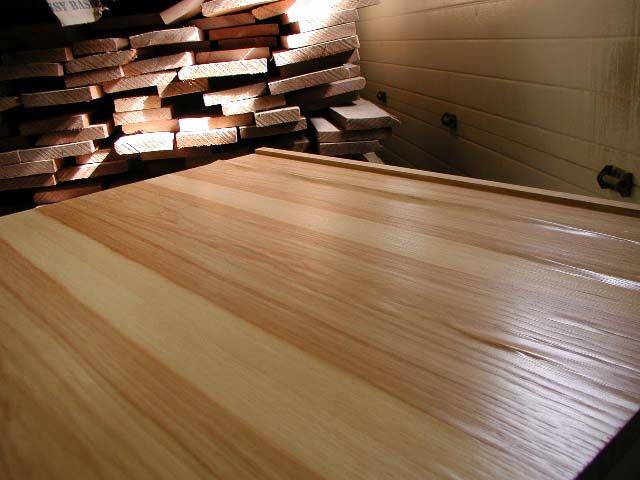Question
I have a problem with some 3M peel and stick veneer. As you can see in the picture, the veneer is not just coming loose and bubbling, it seems to be buckling as if the veneer is absorbing moisture, similar to a hardwood floor that has been flooded. If you could see the back edge of the veneer where I trimmed it off with a router after application, you would see a small overhang, as if the veneer is growing in width.
The product is hickory veneer and is applied to the melamine gable end of some cabinets. I thoroughly sanded the melamine with an ROS and cleaned the surface with lacquer thinner after sanding and just before applying the veneer. Here is where I may have made an error: I use a plastic laminate roller to apply the veneer. The instruction clearly states not to use a roller, but a wide, flat paddle to press the veneer to the substrate.
Finish schedule: one coat of Zinsser seal coat followed by two coats of Fuhr's 375 (water based pre-cat lacquer). The owner of the house where these cabinets are installed went on a 6-7 week vacation and found the buckling veneer when she returned. During that time, the house was neither heated or cooled, the furnace was shut off and there was no air conditioning.
Where did I go wrong? Was it the product? Was it rolling it on instead of pressing it on, as the instruction said? Is there a better way to veneer over melamine?

Forum Responses
(Cabinetmaking Forum)
From contributor R:
This is a common problem that I've seen with peel-and-stick veneers applied to interior doors. I think you also increased the movement issue by trying to stick it onto melamine. Melamine, even when sanded, is slippery and the adhesive for peel and stick isn't that great. Seasonal moisture probably caused the veneer to expand and the adhesive just let it do what it wanted to. End result, it buckled.
If the other side of the panel must be melamine, then you should use single sided panels when veneering one side. Veneer should be either contact cemented or veneer-glue-and-pressed for best bond/hold. If you use contact cement, use the solvent based instead of the water based cement for best bond.
If you want to try to save what you have, then pull the veneer with lacquer thinner and a putty knife, mark a big "no sand this side!" on the keeper side in grease pencil and send the panels through a wide belt sander to completely remove the melamine from the veneer side of the panels. Then re-veneer with new veneer using either contact cement or a veneer press.
To answer your question about what went wrong, I think the product you are using is unfit for the intended purpose.
I talked to my supplier of the 3M peel and stick veneer yesterday and they seemed very surprised at my dilemma. The supplier is putting me in contact with one of the other local cabinet companies who uses this product regularly in the same situation as I did. They claim he buys over fifty percent of their peel and stick hickory veneer and has never complained.
Of course, Gene W. is correct about the wood movement, but it (the bubbling) wouldn't have occurred with plywood or proper veneering.
I have often thought that a cabinetmaker, flooring maker, table maker, etc. should make sure that they post a notice that states that the RH around a wood product must not vary beyond conventional values. If the RH gets extremely low or high for several days, then any guarantees are cancelled, etc. I do know that one kitchen cabinetmaker date stamps all their doors with a UV ink that is invisible in normal light. They guarantee their doors for 2 years. They are always amazed at how many doors are returned that are many years old.
My theory: If there was a heavy coat of shellac which didn't dry fully before topcoating - shellac being an evaporative coating drying from the top down - then, in the heat of the closed house, the un-evaporated alcohol in the shellac, unable to get out through the topcoat, attacks the adhesive under the veneer. Most 3M adhesives dissolve in alcohol.
How far off-base am I?
P.S. In the early 70s when I was selling cabinets, we referred to a finished side that was seen as a gable end, and it cost more. Am I dating myself?